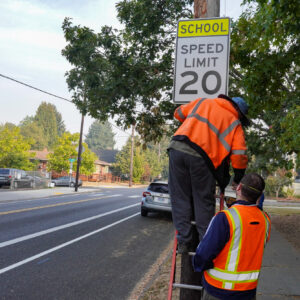
Bike Shelter Project Development Guide.
In an effort to make bicycling even more appealing to students, staff, and parents, Portland Public Schools (PPS) now offers a Bike Shelter Project Development Guide (PDF).
The new guide was developed in conjuction with the City of Portland’s Safe Routes to School program. PBOT’s Safe Routes team has been building momentum for more bike shelters since (at least) March 2010, when they installed shelters at four local schools. According to Safe Routes staffer Clay Veka, the PPS guide emerged from talks between local school leaders and PBOT back in February.
PPS says the guide is part of their commitment to, “providing school environments that use a holistic approach in promoting and protecting children’s health, wellness and ability to learn.” PPS funded the development of the guide, and will pay for the custom steel bases used for the shelter’s posts, through a federal healthy living grant.

The guide lays out all the steps needed to streamline the bike shelter installation process. It provides school leaders with pre-engineered drawings, an itemized list of the materials and parts needed, and resource information for how to source them locally. The coolest part is that the shelters can be built with simple tools by volunteers or school maintenance staff. Each shelter will cost schools about $1,000 (extra if they need to pour a concrete pad), and they were purposely designed to not require a land-use or permit application.
Learn more about PBOT’s Safe Routes to School program on their website.






Thanks for reading.
BikePortland has served this community with independent community journalism since 2005. We rely on subscriptions from readers like you to survive. Your financial support is vital in keeping this valuable resource alive and well.
Please subscribe today to strengthen and expand our work.
Are there opportunities to volunteer and help build/install these for local schools? Perhaps a partnership with Habitat for Humanity?
It only took PPS about 20 years to finally do something like this
At least they are going in the right direction and not banning biking to school like some communities.
At first I thought that they were going to put a flat roof on that. Angled, MUCH better!
Devil’s advocate:
Why do bicycles need a roof only? Bikes are designed to be outside in the elements.
What utility does such a shelter provide the average tax paying parent of a child going to such an equipped school?
It seems to provide only minimal protection from the elements while
being 80% of the cost of a secured bike storage lockerroom without any added security over bare staple racks.
Why is this an improvement?
Sell it with facts, not wishes and dreams, and you’ll sell it to the masses.
q’ Tzal. You may not see the benefit, but I do. I hate showing up to pick my kids up from school and their panniers with stuffed animals and homework are soaked because their bikes have been rained on. And some seats are not good in the rain. Also, a cover makes the process of unstrapping babies and dealing with kids, jackets, other cargo much nicer when it’s raining or hot. These shelters are also important because they send a signal to school-goers that bicycling is encouraged/promoted/welcomed/respected. That in turn gets more people to try it out, which then vastly increases the quality of the school experience and the surrounding community. The ROI on this type of thing is astronomical.
Good, say that.
And it all seems so reasonable.
And I even agree.
BUT … the general public will require the same blunt/concise factual explanation you just gave me and not the character assaination that comes frome others.
“High and mighty” and “moral superiority” have played out very poorly in the political arena in the past even in the bike nirvana that is Portland.
With fiscal purse strings tighter than they have been in many years you should expect to have to explain that to the rest of the populace who will likely see this as a wasteful expenditure that does not directly improve the educational experience of our floundering public schools.
Remember: you can be right and still be voted down by the ignorant masses.
would you park your convertible outside in the rain with the top down and the hood up?
80% of the cost of a secured bike locker room? Where in the world can you build a secure bike locker room for $1200? Are you assuming that every school has a vacant room already?
Chain link that enclosure and put a padlocked door that only gets opened when school starts and ends. The door would be opened by administrative staff.
Theft prevention: better than nothing, not near as good as a secured indoor room.
I’m gonna take a wild stab at it, and assume that q’Tzal is not a parent in a cycling family with wee ones. This is a nice looking amenity in my opinion, I would be more than willing to volunteer to install 3 of them at my child’s school.
Without some kind of walls, bikes on the perimeter will take a lot of abuse from rain. Better though, than no shelter from the rain at all.
Without tiered racks that allow bikes to be parked above bikes parked on the ground, sheltered space wouldn’t be efficiently used.
Great idea to have made an effort to allow shelters to be built for less than the usual astronomical expense for something as simple when accomplished through the usual bureaucratic song and dance. Safe, good looking, functional shelters could probably built for a lot less than $1000 if people were willing to allow salvaged materials to be used.
This is awesome! Businesses, employers and apartment/condo building owners should take note of this simple way to provide covered bike parking.
I forwarded the PDF to my facilities department.
Love it. Turns it into a “yes we can!” opportunity.
It all sounds great, but I’m a bit skeptical that they could have been designed to not require a land use or permit application, esp. the land use application.
It seems more likely that they were designed to be APPROVABLE in most situations (meaning the correct zoning, correct distance from property lines, etc.)
In the case of some projects, if you meet certain requirements, you can skip the reviews and permits (i.e. you’re exempt) but more typically, you still have to go through the red tape (land use review and/or building permit) so the jurisdiction can see for itself that you’re approvable.